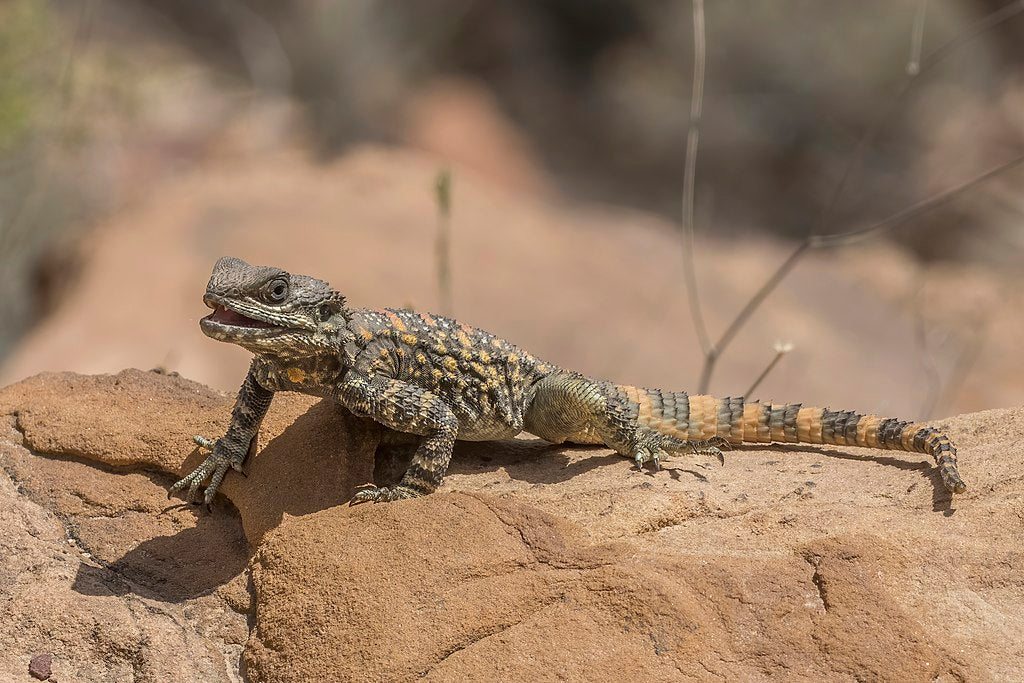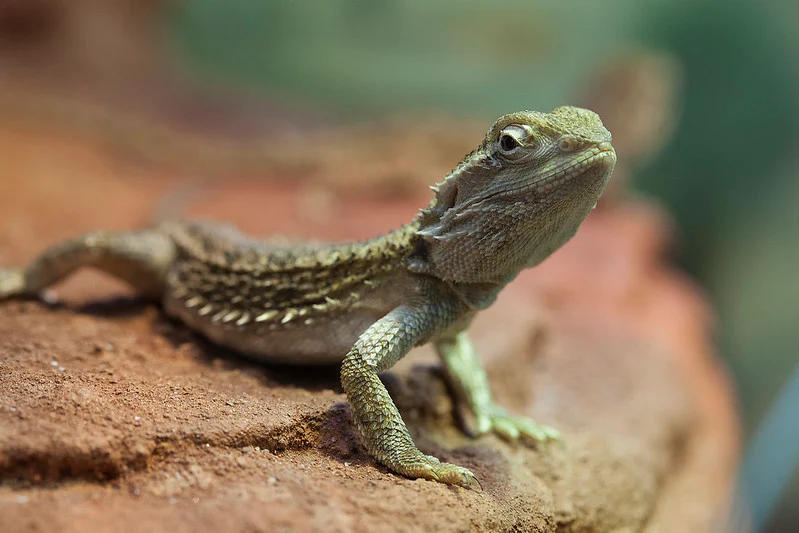Pygmy chameleons are a group of small, semi-arboreal lizards native to Kenya, Malawi, Tanzania, and Somalia. Classified under the Rhampholeon and Rieppeleon genera, these tiny chameleons generally prefer montane forests where they occupy vegetation close to the forest floor, as well as the leaf litter.
Pygmy chameleons generally grow to 2-3.5” long and have a variable appearance depending on species. Generally speaking, coloring is gray, brown, yellowish, and/or green with a leaflike pattern. Some have textured skin and/or a soft rostral (nose) protuberance. The tail is short, and may or may not be prehensile.
Chameleons are generally sensitive, and pygmy chameleons are more difficult to keep successfully than others. Pygmy chameleons have a reputation for extremely short lifespans, but with appropriate care, they can live up to about 6 years.
How much space do pygmy chameleons need?
Although they may be tiny, a single pygmy chameleon should still be housed in no smaller than a 18”L x 18”W x 18”H enclosure. Of course, larger is better, particularly longer! You will need a front-opening, well-ventilated enclosure. This can be glass or PVC with particularly good ventilation, or a modified screen enclosure with thin PVC panels covering the sides and back. This helps retain humidity and give the chameleon a better sense of security in its enclosure. The base of the enclosure must be able to support a full substrate layer without leaking.
Although pygmy chameleons do fine when housed alone, a group can be housed together if the enclosure is large enough to prevent crowding and males are not kept together. Males may fight and injure each other when restricted to the same enclosure. The enclosure’s size should be increased by at least 5 gallons per additional chameleon.
Do pygmy chameleons need UVB?
Low-intensity UVB lighting is required for pygmy chameleons to stay healthy. Aside from helping provide a day/night cycle and providing an infinite supply of vitamin D, UVB is also good for the lizard’s overall health. Here are the best UVB bulbs for pygmy chameleons housed in a 18-24” tall enclosure:
- Arcadia ShadeDweller Arboreal UVB kit
- Zoo Med T8 Reptisun 5.0
The basking branch should be positioned so the chameleon’s back can get no closer to the UVB bulb than 6”. This may require raising the UVB fixture above the top of the enclosure with the assistance of a couple small blocks of wood or similar. The UVB bulb should be roughly half to two-thirds the length of the enclosure housed in a reflective reptile-branded fixture appropriate to your type of bulb. Make sure that the fixture your UVB bulb is housed in does not have a clear plastic bulb cover, as plastic and glass block UVB!
If you are using live plants in the enclosure, then UVB lighting will not be enough — you will need an additional fluorescent ~6500K plant grow lamp to keep the plants healthy.
Provide 12 hours of light each day to simulate daylight.
What basking temperatures do pygmy chameleons need?
Pygmy chameleons do well at average room temperature, but it’s best to provide a gentle basking area temperature of 77-80°F and a general air temperature between 68-75°F. Take special care that ambient temperatures never rise above 80°F!
Temperatures should be measured with digital probe thermometers, with probes placed on the basking spot and the floor on the cool side. The basking surface itself should be a sturdy wood branch or vine placed near the top per the specifications listed previously.
Provide heat for your chameleon with a low-wattage white incandescent heat lamp placed on one side of the enclosure in a hood fixture. For best results, elevate the lamp above the top of the enclosure with wood blocks. Do not use ceramic heat emitters (CHEs), heat mats, red bulbs, or blue bulbs, as these are not as effective.
The heat lamp must be turned off at night. Nighttime temperatures should drop down to somewhere between 58-65°F — if your room temperature doesn’t drop that low, you will need the assistance of a portable cooler such as the Zoo Med Repti Cooler.
What humidity levels do pygmy chameleons need?
Pygmy chameleons do best with high humidity levels (60-80%) during the day and higher at night (80-100%). Mist lightly 2-3x/day with a pressure sprayer, then run a humidifier on and off over the course of the night.
Reptile humidifiers and foggers should only be used with distilled water and require frequent disinfecting to keep your reptile from getting sick.
Humidity should be measured with a digital probe hygrometer, with the probe placed in the middle of the terrarium. Humidity levels that are consistently too high or low will make your chameleon sick!
What substrate is good for pygmy chameleons?
Unlike other chameleons, substrate is a requirement for pygmies since they spend a significant portion of their lives on the forest floor. Provide at least 3” of well-draining, moisture-retentive substrate to accommodate your pet’s needs. This is also a necessity if you plan to use live plants in the setup.
We recommend the following substrates for pygmy chameleons:
- Zoo Med Eco Earth
- Zoo Med ReptiSoil
- Exo Terra Plantation Soil
- Zilla Jungle Mix
You will also need a layer of clean, chemical-free leaf litter on top of the substrate.
Substrate should be completely replaced every 3-4 months. Remove poop and urates daily, along with any contaminated substrate.
What décor can you use in a pygmy chameleon terrarium?
A bare, minimalistic enclosure leads to a stressed chameleon — and a stressed chameleon is a chameleon that quickly gets sick. In order to create a functional setup for your pygmy chameleon, you will need plenty of thin branches, vines, and plants (preferably live). Arrange the foliage to create hiding places for the chameleon to use as needed, with an open area under the heat lamp.
What do pygmy chameleons eat?
Pygmy chameleons are strictly insectivorous, which means that they need to eat a variety of insects to get the nutrition that they need. How much they need to eat varies depending on age:
- Babies (0-3 months) — As much as they can eat, 2-3x/day
- Juveniles (3-6 months) — 6-10 small crickets/day
- Subadults and Adults (>6 months) — 4-6 small crickets every other day
Feeder insect options: crickets, discoid nymphs, dubia nymphs, red runner roaches, red head roaches, house flies, flightless fruit flies, small hornworms, small silkworms
Feeders should be at least slightly smaller than your chameleon’s head. Remember, variety is key to great nutrition!
Supplements
You will also need calcium and vitamin supplements to prevent your chameleon from developing a deficiency. Follow this schedule for supplementing a pygmy chameleon:
- Every feeding: Arcadia EarthPro A
- Once per month: Repashy Calcium Plus LoD
It is also important to make sure that all feeders are well hydrated and gutloaded!
Do pygmy chameleons like to be handled?
Truthfully, few reptiles actually “like” to be handled. When it comes to pygmy chameleons, while they’re not as delicate as they look and they tend to not be fazed by humans, it’s best to take a hands-off approach with these reptiles. However, it’s best to work to develop a bond of trust with your pet via facilitating as many positive interactions as possible. Offering food from feeding tweezers is a good way to bond.
*This care sheet contains only very basic information. Although it’s a good introduction, please do further research with high-quality sources to obtain additional information on caring for this species.
"Rieppeleon brevicaudatus 27996531" by Louis Imbeau is licensed under CC BY 4.0.




Leave a comment
This site is protected by hCaptcha and the hCaptcha Privacy Policy and Terms of Service apply.